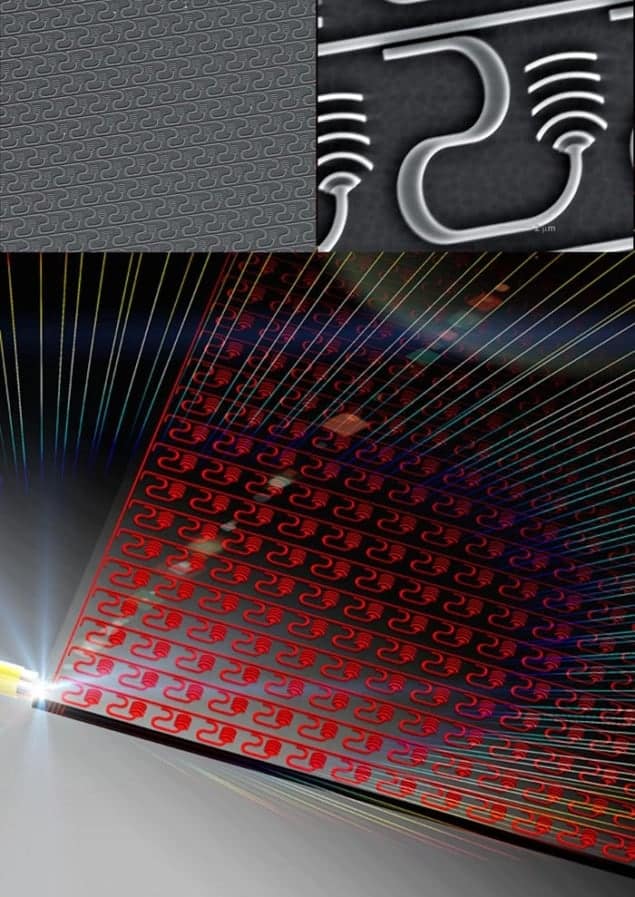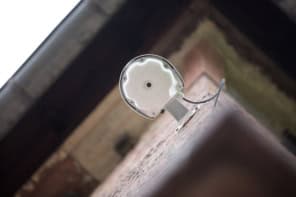
The first large-scale array of optical antennas on a silicon chip has been made by researchers in the US. The structures, which can generate accurate pre-defined patterns of light, could be used in a host of new application areas, including 3D holography displays and advanced medical imaging.
Antennas have long been used to transmit radio and television waves, but researchers have only recently begun to extend this concept to visible light. All antennas work by oscillating charges along their structure, which means that the size of the antenna must fit to a resonant mode for the wavelength of the electromagnetic radiation it supports. To make an antenna work at optical frequencies, it must thus be scaled down to nanometre dimensions.
The idea of connecting up multiple radio antennas, fed from a common source, has been around for a long time too. Here, the antennas are aligned in phase to enhance the emission of radio waves in a given direction. The technique is also routinely employed in astronomy, where information from multiple telescopes is collected in phase to improve the resolution of the entire set-up.
Thousands of antennas
Now a team led by Michael Watts at the Massachusetts Institute of Technology (MIT) has extended the concept to infrared light and has succeeded in fabricating an integrated optical phased array containing more than 4000 antennas on a single chip that has an area of little more than 0.5 × 0.5 mm. This is equivalent to an array of 64 × 64 antenna units, or pixels, with each pixel covering 9 × 9µm.
The antennas are made from a strong, high-index contrast dielectric grating and all work at the same power level. They are all aligned in phase to produce a sophisticated light pattern – in this case, the MIT logo, in the far field. “To our knowledge, this demonstration represents the largest coherent combination of silicon nanophotonic elements ever produced,” says Watts.
The researchers say that they are able to accurately control the direction in which light is emitted from the array and steer an emitted light beam in two dimensions.
Watts and colleagues made their phased array in a conventional 300 mm complementary metal-oxide–semiconductor (CMOS) fabrication facility using state-of-the-art tools, such as optical immersion lithography.
Imaging and 3D holography
According to the team, the arrays could be used for beam steering in sensing applications, such as light detection and ranging (LIDAR) and interferometry. The devices could also find use in medical images because they could be used to take images through light-scattering materials such as biological tissue. Such imaging makes use of “adaptive optics” techniques that automatically adjust the phase of an optical wave to compensate for the distortion caused by the surrounding medium – something that calls for accurate phase control of the light beam being employed and a huge number of pixels, two characteristics that the new optical phased arrays possess. One immediate application would be in intravascular surgery, to steer laser beams and image vascular walls, says Watts.
I believe that 3D holographic displays are not only possible now, but [are] within our grasp
Michael Watts, MIT
“However, I think the most interesting application for these arrays is in 3D holographic displays,” he says. “I believe that 3D holographic displays are not only possible now, but [are] within our grasp. This is because our array allows for separate control over the phase and amplitude of the light wave emitted as well as single-point excitation of the nanophotonic emitters, enabling truly arbitrary holograms to be generated entirely on-chip for the first time.”
He adds that such an application would be even better if the arrays operated at visible optical wavelengths, which are shorter than the near-infrared frequencies demonstrated in the current work. “To achieve this, we will now be working on reducing the arrays’ pixel size even further and using a material other than silicon for the waveguide in the structure, since silicon absorbs light in the visible part of the spectrum.”
The research is described in Nature.



